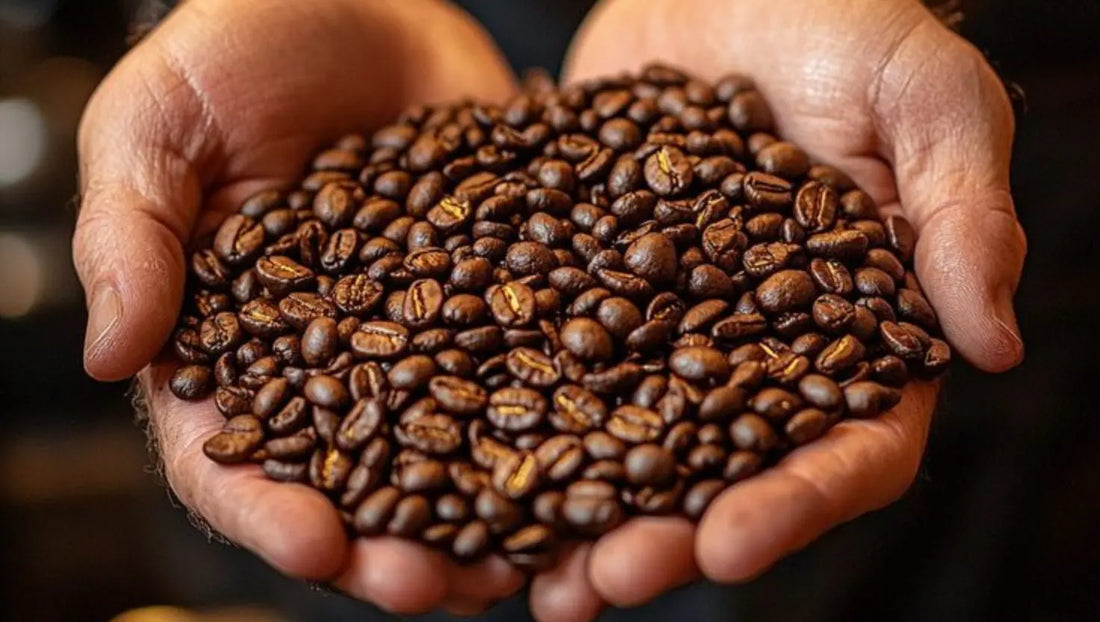
How to Tell If Your Coffee Beans Are Truly Fresh or Just Repackaged
Share
TLDR;
You can tell if your coffee beans are truly fresh or repackaged by checking for a roast date, smelling for a strong aroma, looking for a glossy sheen, and testing for CO₂ release during brewing. Fresh beans from Milk & Honey Coffee Co. will have rich aroma, vibrant flavor, and visible oils, while stale or repackaged beans will look dull, smell flat, and taste lifeless.
Why Freshness Matters in Coffee Beans
Freshness determines everything about your coffee’s taste. When coffee beans are freshly roasted, they release carbon dioxide and retain natural oils that give coffee its signature aroma and flavor. Over time, exposure to oxygen, light, and moisture breaks these compounds down, leading to stale, bitter, or flat-tasting coffee.
When beans are repackaged, they often appear fine at first glance, but they’ve already lost much of their aromatic quality. Coffee lovers and professionals at Milk & Honey Coffee Co. know that truly fresh coffee delivers balance, depth, and brightness that stale beans never match.
Look for a Clear Roast Date, Not a “Best By” Label

The roast date is the most reliable indicator of freshness. A bag that lists only a “best by” date hides the real timeline.
Here’s what to check:
-
Roast date clearly printed: Indicates when the beans were roasted.
-
Avoid missing or vague dates: “Best by” means the roaster doesn’t want to disclose how old the beans are.
- Optimal window: Fresh beans usually reach peak flavor between days 5–21 after roasting this is the key period for how long roasted coffee lasts before flavors begin to fade.
When buying from local roasters like Milk & Honey Coffee Co., always look for transparent labeling. Roasters proud of their quality will never hide the roast date.
Packaging Features That Indicate Freshness

Packaging tells you a lot about whether beans are truly fresh or simply repackaged.
Key freshness indicators include:
-
One-way valve: Allows CO₂ to escape without letting oxygen in. This valve prevents overpressure while maintaining freshness.
-
Opaque, sealed bag: Protects beans from light and air. Avoid clear plastic or resealed packaging.
-
Puffed bag: Indicates degassing—a sign that beans were freshly roasted and still releasing CO₂.
If the bag looks flat, resealed, or lacks a valve, the beans are likely old stock repackaged to look new.
Visual and Aroma Clues That Reveal Freshness

Your senses are powerful tools for checking coffee bean quality.
-
Color: Fresh beans have a consistent brown tone. Stale beans appear faded or uneven.
-
Sheen: Look for a light, oily gloss, especially on darker roasts. Those oils are aromatic compounds. Dull, dry beans often mean long storage.
-
Smell: Fresh coffee should fill the air with a rich, lively aroma. Stale beans smell papery or musty.
-
Texture: When you gently squeeze fresh beans, they should feel slightly oily, not dry or brittle.
At Milk & Honey Coffee Co., baristas check beans daily by smell and appearance to ensure every batch meets freshness standards.
The CO₂ Bloom Test: A Reliable Home Freshness Check

One of the simplest ways to test coffee bean freshness is the CO₂ bloom test.
Follow these steps:
-
Grind a small amount of beans.
-
Place the grounds in a pour-over or French press.
-
Pour a little hot water over the grounds.
-
Watch for bubbling or foaming.
A strong bloom shows CO₂ release from a fresh roast. If there’s little or no bubbling, the beans are old. This reaction is a natural sign of degassing from fresh coffee, something repackaged beans no longer show.
Taste Test: The Flavor Tells the Truth

Taste never lies. Brew a small cup and pay attention to these qualities:
-
Fresh coffee: Vibrant flavor, balanced acidity, sweet notes, lingering aftertaste.
-
Old or repackaged beans: Dull, bitter, and lifeless. Often described as cardboard-like.
If your espresso lacks crema or your pour-over feels thin and flavorless, the beans are likely stale. At Milk & Honey Coffee Co., we always recommend tasting side by side—one fresh roast, one older bag—to train your palate.
Common Signs Your Coffee Beans Were Repackaged or Old

Repackaging happens when distributors rebag old stock to extend shelf life. Here’s how to tell:
-
The bag seal looks tampered or resealed.
-
The aroma is faint or nonexistent.
-
There’s no roast date, only a “best before.”
-
Beans feel dry and brittle.
-
Deep discounts or clearance sales often indicate aging stock.
When in doubt, trust smaller, reputable roasters that roast and ship immediately—like Milk & Honey Coffee Co.—rather than bulk resellers.
How to Test Coffee Bean Freshness at Home

Practical checks help you confirm what the label says. Try these methods:
-
Smell test: Open the bag and inhale deeply. If you don’t smell much, they’re old.
-
Visual check: Uniform color and sheen means freshness.
-
Bloom test: As described earlier, bubbling equals freshness.
-
Brew test: Compare flavor and aroma across multiple brews.
A good practice is to mark when you open the bag. If it’s been sitting for over three weeks, expect flavor loss no matter the storage.
Best Practices to Keep Coffee Beans Fresh After Opening

Even the freshest beans lose flavor if stored poorly. Proper storage extends freshness and flavor.
Keep in mind:
-
Buy in small batches: Enough for one to two weeks.
-
Store in airtight containers: Use opaque, vacuum-sealed canisters.
-
Avoid light, heat, and moisture: Keep beans in a cool, dark place.
-
Minimize air exposure: Don’t leave bags open or containers unsealed.
At Milk & Honey Coffee Co., we recommend using the bag’s one-way valve packaging or transferring beans to airtight containers immediately after opening.
Coffee Bean Freshness Myths That Mislead Buyers

Many myths circulate about how to preserve or identify fresh coffee. Here are common ones:
-
Myth 1: Beans last forever if sealed.
-
False. Even sealed, oxidation continues slowly, dulling the flavor.
-
False. Even sealed, oxidation continues slowly, dulling the flavor.
-
Myth 2: Freezing always preserves freshness.
-
Sometimes true, but only if done once. Repeated thawing and freezing ruins the beans.
-
Sometimes true, but only if done once. Repeated thawing and freezing ruins the beans.
-
Myth 3: Ground coffee is as fresh as whole beans.
-
False. Grinding accelerates oxidation by exposing more surface area. Always grind before brewing.
-
False. Grinding accelerates oxidation by exposing more surface area. Always grind before brewing.
Fresh Coffee Beans vs Old Beans: What Changes Should You Notice
When comparing old and fresh beans, look for these contrasts:
-
Smell: Fresh beans smell complex and aromatic. Old beans smell stale.
-
Taste: Fresh coffee has clear, lively flavor. Old coffee is bitter and flat.
-
Appearance: Fresh beans shine with light oil. Old beans look dry and dusty.
-
Brewing performance: Fresh espresso produces rich crema. Old beans don’t foam.
These differences show why sourcing from trusted roasters like Milk & Honey Coffee Co. makes such a difference in your cup.
Why Fresh Coffee Beans Are Worth It

Fresh beans give you better flavor, aroma, and value. When you invest in freshly roasted coffee, you experience the product as intended by the roaster.
For home brewers, that means more satisfying cups and fewer wasted bags. For cafes, it builds trust and repeat customers.
Choosing truly fresh beans also supports ethical supply chains. Roasters like Milk & Honey Coffee Co. roast in small batches, ensuring consistent quality and transparency from farm to cup.
FAQs about Coffee Bean Freshness
Q: How long do coffee beans stay fresh?
A: Typically 2–4 weeks after roasting, depending on roast level and storage.
Q: Can you drink old coffee beans?
A: Yes, but flavor declines significantly.
Q: Does the one-way valve matter?
A: Yes. It releases CO₂ and protects beans from oxygen, maintaining freshness longer.
Q: Should I refrigerate or freeze my coffee beans?
A: Only freeze if you store in airtight, moisture-proof containers and avoid repeated thawing.

